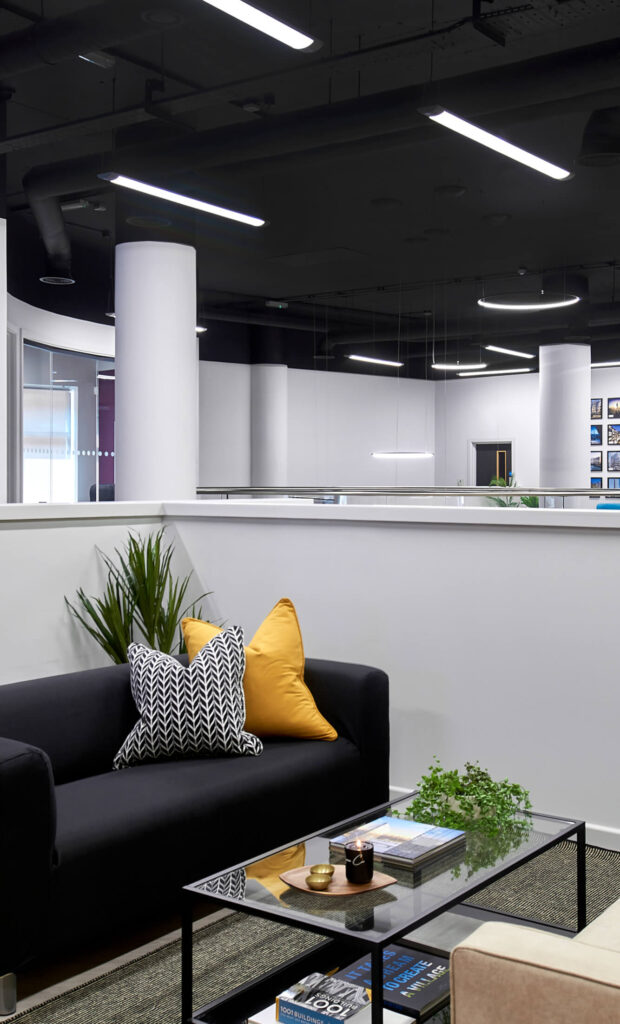Office refurbishment is more than a mere facelift for your workspace; it’s a strategic move that can significantly impact employee satisfaction and productivity in the office. Understanding what employees value in their work environment is crucial for any successful office refurbishment or office fit out project.
This short office refurbishment guide delves into the key elements that make an office space not only functional but also a place where employees feel motivated and valued.
Thinking of a new Commercial Office Refurbishment or Office Fit Out in London?
Want to gain some clarity on what may be involved, the process you’ll go through and everything else you’ll need to be aware of?
Book in a FREE no-obligation call with our team where you can ask all of your questions and get the answers you need.

Read on to find out how to make a good office great and reach out to us at HQ Renovations to discuss your office refurbishment needs.
Office Design – Why Does it Matter?
Office design is about so much more than simply aesthetics. How employees feel in the space, is just as important as its functionality and visual appeal. Office design has been found to immensely influence productivity, efficiency, and overall employee satisfaction.
It can be used as a strategic tool for growth with a focus on co-worker interactions actually found to increase sales and new-product launches. Employees who feel calm and comfortable in their workplace setting will contribute greatly to a less stressful and more productive atmosphere.
It’s important to consider the flip side of this: what happens when employees don’t like their environment? We encounter the opposite; dissatisfied workers, low productivity, and innovation met with high turnover and increased sick calls.
As an office building owner or manager, it’s in your best interest to invest in office design – not just because it will look better and resell for more (although these are great benefits too!), but because it improves the experience for those who work in it every day.
What Do Office Workers Value?
1. Modern Design and Amenities in Office Refurbishment
Modern design and amenities play a pivotal role in any office refurbishment project. Employees appreciate a workspace that’s not only aesthetically pleasing but also functional and comfortable. This includes everything from ergonomic furniture to efficient heating and cooling systems. A modern office fit out should also incorporate elements like natural light, green spaces, and comfortable break areas.
Investing in quality amenities during the office refurbishment process can have long-term benefits. For instance, ensuring that the office has a reliable internet connection, modern appliances in the kitchen, and well-maintained restrooms can significantly improve the daily experience of employees. These seemingly small details can have a substantial impact on morale and productivity.
2. Convenience and Efficiency in Commercial Office Refurbishment
Convenience is a key factor in modern office fit outs. An efficiently laid out office can save employees time and reduce frustration. This includes having a logical flow to the office layout, ensuring that frequently used areas are easily accessible, and minimizing unnecessary movement.
For example, positioning printers, copiers, and other shared resources in central locations can increase efficiency. Additionally, consider the convenience of technology integration. Providing ample power outlets, reliable Wi-Fi, and user-friendly technology can streamline work processes.
One of the goals of an office refurbishment is to create an office environment where employees can focus on their work without being hindered by logistical inefficiencies.
3. Embracing Technology in an Office Fit Out
In today’s digital age, integrating up-to-date technology is crucial in any office refurbishment or office fit out process. This goes beyond having the latest gadgets; it’s about ensuring that the technological infrastructure supports the needs of the business and its employees. This could mean investing in high-speed internet, efficient software systems, or advanced communication tools.
Technology should be used to enhance the workflow and make daily tasks more manageable. For instance, implementing a digital workflow platform can facilitate immediate feedback and collaboration, reducing the need for outdated and time-consuming processes.
Thinking of a new Office Fit Out or Office Refurbishment in London?
Want to gain some clarity on what may be involved, the process you’ll go through and everything else you’ll need to be aware of?
Book in a FREE no-obligation call with our team where you can ask all of your questions and get the answers you need.
4. Integration and Flexibility in Office Space Design
Creating a flexible workspace is essential in modern office space design. This includes having areas that can be easily reconfigured for different purposes, such as collaborative projects or individual work. Flexible workspaces encourage innovation and adaptability, which are key in today’s fast-paced business environment.
Integration also plays a significant role in office refurbishment. Designing spaces that encourage cross-disciplinary collaboration can lead to a more dynamic and innovative workplace. This might involve creating open-plan areas, communal workspaces, or multipurpose rooms that foster interaction and idea exchange.
5. Balancing Privacy and Collaboration in an Office Refurbishment
While collaboration is important, it’s equally crucial to provide spaces for privacy and focused work. This balance can be achieved by offering a variety of workspaces that cater to different needs.
For example, quiet zones or soundproof booths within your office space design can be designated for tasks requiring concentration, while open areas can be designed for teamwork and meetings.
Strategically placed communal areas like coffee stations or lounges can encourage informal interactions and breaks, fostering a sense of community within the office environment. The key is to provide options so employees can choose the environment that best suits their work style and needs at any given time.
Final Thoughts on our Office Refurbishment Guide To Creating Workspaces Employees Love
A successful office fit out or office refurbishment is one that takes into account the needs and preferences of its users. By focusing on modern office space design, convenience, technology integration, flexibility, and the balance between privacy and collaboration, businesses can create office spaces that not only boost productivity but also enhance employee satisfaction.
Remember, a well-designed office is an investment in your company’s most valuable asset – its people.
Thinking of a new Commercial Office Refurbishment or Office Fit Out in London?
Want to gain some clarity on what may be involved, the process you’ll go through and everything else you’ll need to be aware of?
Book in a FREE no-obligation call with our team where you can ask all of your questions and get the answers you need.



